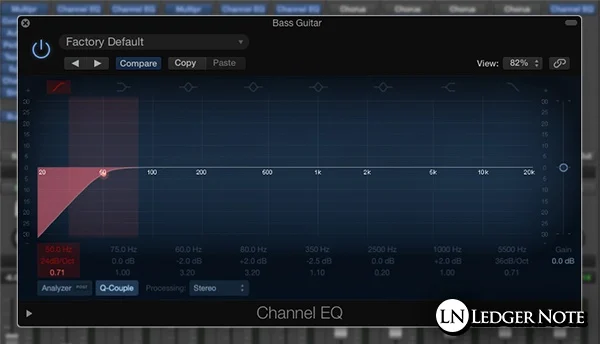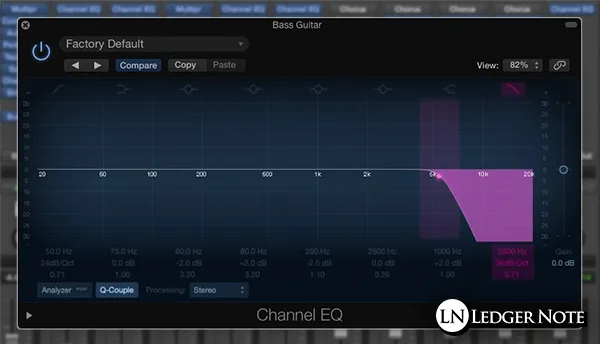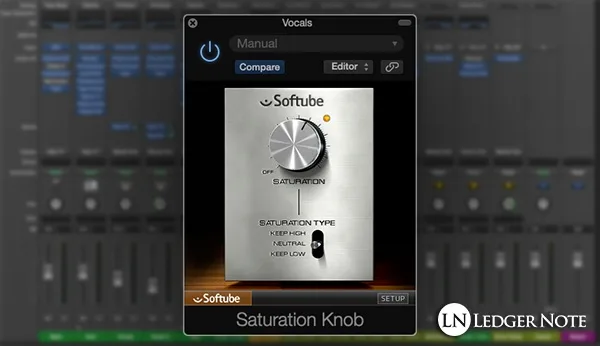
The sub-bass and bass frequencies of a song are everything. Get it right and you’ll hear endless praise. Mess it up and your entire mix will suffer. The bottom is the foundation and has to be solid.
There’s endless discussion about various attempts to provide a rock solid groove that drives a song to the top of the charts. From equipment and playing technique to recording and mixing tricks, it’s been explored to the depths. And that’s all because people can’t get the basics of bass guitar EQ right.
Yes, volumes matter. Making room for the kick drum matters. Compression and tricks with chorus and flangers can help. But nothing beats the ultimate tool for the job, the parametric equalizer.
Today we’ll cover exactly how to EQ for a pristinely clear bass guitar track that doesn’t compromise. I’ll even warn you of the dangers of how people destroy their perfectly crafted EQ with other signal processing tools, too.
By the end you’ll still have punch, harmonics, and a track that balances well with the rest of your mix that sounds perfect on any sound system, whether that be ear buds, in the car, with a subwoofer, or otherwise.
Bass Guitar EQ Settings – Things to Know First
As a rule of thumb, before you do anything else (besides tasks like cleaning up silent regions) you’ll reach for the equalizer. That goes for any instrument and any track. All audio processing effects act upon the signal you feed them, so it makes sense to hone the tone first.
Every Track is Unique – It must be stated that every bass guitar recording, whether recorded with a microphone on the amplifier, direct injected into an audio interface, or even a large stand up bass will require unique EQ settings. Even the exact same bass guitar recorded 15 minutes later will end up needing slightly different adjustments.
Mix With Your Ears – I say that to emphasize that, while many of these tips can be followed broadly every time, the specifics will need to change. And nobody can tell you exactly what to do at that level of detail. You will have to focus with your ears to make the right decisions!
Work in Solo & in Context – When doing precision work to shape the bass tonal characteristics themselves, you’ll want to listen in solo mode for the most part so that you only hear the bass guitar. When making broad decisions listen to the bass along with the full mix. When balancing the bass versus any other instrument, you can solo them both so you only hear them in contrast with one another.
Use Headphones or a Subwoofer – If you have acoustic treatment (especially bass traps) in your mixing room and the best studio subwoofer you can get your hands on, use those. Otherwise you’ll need a set of studio headphones with frequency response that reaches at as low as possible. If you can’t hear the low-end clearly, then you can’t make the right decisions.
Let’s start with the broad strokes. These are things you’ll be doing every time immediately before any other type of EQ work. I prefer to do it all on one single parametric EQ plugin, myself, and then reach for an additional one later if needed.
High Pass Filter for Sub Bass Roll Off

This may sound strange to you, but the first thing I do is set up a high pass filter. The name tells you what it does. It allows high frequencies to pass through and blocks out low frequencies. “But why would I want to do that to a bass guitar?” There’s two reasons to do this.
Control the Sub-Bass Frequencies – First and foremost, you have to get your sub-bass frequencies under control. You may not hear them in your headphones or cruddy speakers, but anyone with a subwoofer will. If you’re not able to hear them enough to work with them, then less is more.
With sub-bass, if you can’t get it exactly right, then you need to provide too little. Otherwise you’ll ruin your headroom in the mix, cause potential distortion for your listeners, or simply ruin the balance of the mix otherwise.
Make Room for the Kick Drum – In most music these days, the kick drum will own a lower segment of the bass frequency range than the bass line itself will. Though I said “own,” the truth is the kick and bass have to share this region, but the kick will be dominant.
So by reducing the sub-bass gradually towards 20 Hz in your bass track, you make more room for the kick to be felt rather than just be an additional “smear” within the bass region. This balance is critical and I have a lot more tips for you below regarding this.
A General Starting Point – When EQing bass with a bass roll off, I recommend setting the main frequency around 50 Hz with a steep enough Q that you gradually but quickly reduce the volumes the closer you get to 20 Hz. This will allow some sub-bass but ensure you aren’t rattling speakers.
This will allow for a much more articulate sounding mix in the low-end, providing clarity to both the kick drum and the bass by reducing the muddy sound you get from them clashing. Intelligibility and clarity in the bass requires it to be contrasted against something clearly, and that’s the kick.
Add a Low Pass Filter (High Roll Off)

With bass, the energy and power comes in around 60 Hz to 150 Hz, and then the clarity comes from the harmonics and overtones that occur all the way up to around 5 kHz or a bit higher. These harmonics are what the human ear focuses on, while the energy is mainly felt.
Keep the Harmonics, Kill the Noise – So generally, there’s no useful information or sound above around 5 kHz in bass tracks. But you’ll likely have room reverb, digital noise, hiss and crackle, string noise, and other unwanted sounds above that. So a low pass filter will either cut that out entirely or drastically reduce their volumes.
Make Room for Hats, Cymbals, Vocals, Etc. – In dense mixes, getting rid of any extra sound will make room for other instruments, especially when their fundamental frequencies and harmonics live in that range. Chimes, cymbals, hi-hats, vocals, violins, guitar, piano, and much more need these upper frequencies to be free and clear.
Now we have the sub-bass and high-end cleaned up in general. We will return to the sub-bass later, but we’re done with the upper frequencies altogether. Now it’s time to sculpt the general sound of the bass.
Bass Guitar Frequency Ranges

Now we want to sculpt the general characteristics of the bass track. I recommend doing this in two stages. First start in solo mode to create a pleasing sound, and then listen in the full mix to accentuate and de-emphasize ranges that need it.
This is much simpler than other instruments. There’s really only about four bass frequency ranges to concern yourself with:
- 80 Hz – 200 Hz: Energy & Fullness
- 200 Hz – 500 Hz: Muddiness & Boxiness
- 500 Hz – 1 kHz: Punch & Intelligibility
- 1kHz to 5 kHz: Attack, Harmonics, Clarity
You want to ask yourself questions about those descriptive jargon terms in solo mode and in the full mix. If you have the inkling that there’s a problem, there probably is and these ranges are the solution.
When EQing bass (and anything else) you have the choice to either boost or cut, meaning adding volume or reducing it. Unlike other instruments, you really won’t need to get “surgical” with your EQ.
How to EQ Bass Guitar – Stick to adjustments of 2 dB to 5 dB maximum. If you need more than that you have other problems in your recording process or signal chain with pedals or whatever. I recommend recording dry (no reverb, distortion, or any other effects) and add those in the mix where you have full control over them.
Also, in addition to not using large boosts or cuts, you should also use very wide Q’s (curves). This is the opposite of “surgical EQ” and sounds very natural, transparent, and musical. You shouldn’t need tight Q’s anyways, even to make room for the kick drum.
The Most Common Problem – If you can’t “make out” the bass clearly, don’t assume you need to boost the low-end. You don’t. Play with wide boosts around 700 Hz to 2 kHz for the most part to bring out more intelligibility. I have more tricks below that help with this.
Find the Pocket – You don’t always need to do this but sometimes you can find the “pocket” of where the bass guitar lives and where the kick drum lives. These are the main fundamental frequencies of each, and you can boost and cut slightly in these regions respectively, to make a bit more room for each other.
Explanation of the Jargon – Energy and fullness are the opposite of a weak and thin, lifeless track. Muddiness and boxiness come from recording in a small room due to bad acoustics, but will accumulate regardless across all of your tracks.
Punch and intelligibility provide “oomph” during the initial attack of new notes, which is important in getting your listener’s ears and brains to latch on to the bass line. Attack is a part of punch, which is the volume spike when the pick or fingers thump the strings. You want to preserve some of this.
Other Bass Guitar EQ Tricks
While none of these are strictly equalizer functions, they all relate to EQ in some fashion. You’ll need them to put the finishing touches on your mix regardless, especially with the low-end. I’m going to keep this short and you’ll need to research more on your end for a deeper dive.
Compression – You’re absolutely going to compress your bass tracks, more heavily than you expect. This provides consistency where it matters the most, since the sub-bass and bass is where most of the energy of a track resides.
The key here is to use the attack control of the compressor to let the initial attack of each note shine through. Remember, this is important for the listener’s ear to have something to notice and latch on to. You can shape the attack however you want, but don’t squash it out of existence.
Saturation / Distortion / Layering – You may find your bass recording is simply lacking harmonics and thus clarity and intelligibility. You can add some in with one of three methods or a mixture. Saturation will create a subtle, warm, pleasing distortion, or you can try to add that with distortion itself (less recommended).

Saturation and distortion introduce harmonic content and boost what’s already there. Another way to do this is to layer your bass track with another performance of the same melody but using turning up your tone knob or even playing it in a higher octave.
Sidechain Compression – Rather than destroying your beautiful EQ with surgical moves to carve out a space for the kick drum, the best move is to use sidechain compression. What this does is compress the bass track but only when the kick drum sounds off.
This applies ducking to the bass, lowering its volume momentarily just long enough for the kick drum’s attack and body to come through, then the volume returns during the decay tail of the kick. When done right, your listeners will only notice that they can hear the kick drum a lot better.
Phase Issues – For stereo synth bass tracks or any stereo effects added, you may get phase cancellations. This is why I suggest mixing in mono for the most part and always continue to check in mono. Please research this issue as it’s too much to go into here.
Chorus for Stereo Spreading – A final trick I love, especially in pop or rap, is to use an auxiliary bus to target only the upper frequencies of the bass track and to add chorus to it. This will smear it across the stereo field and make it sound huge, but keeping the real energy of the bass in mono.
With these final tricks, you should have no issue sculpting the perfect low-end to your mix. Then as you finish off the rest of your mix you can even put a high pass filter on the master bus to ignore the bass, only adding it back in at the end for the final check.
EQing Bass Guitar Has Never Been Easier!
And that’s it. Your main four items to target are cleaning up the sub-bass, rolling off the top end, sculpting the general sound with broad EQ curves, and then making room for the kick drum. That’s really all there is to it.
All the other tricks and methods people employ are just dodging the real work they don’t know how to do. Bass guitar EQ is really simple if you slow down, understand the principals, and use your ears. Have fun with your way better mixes!